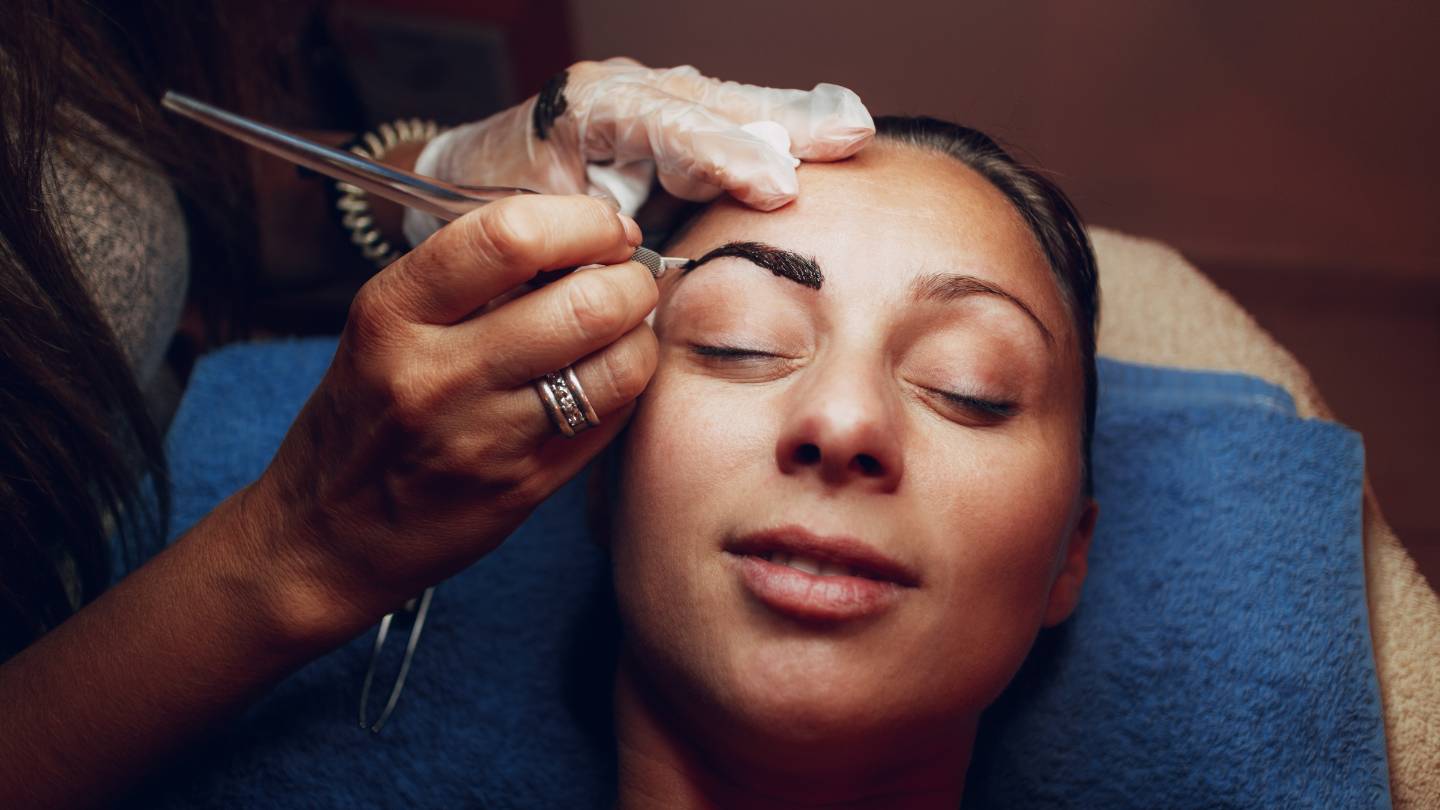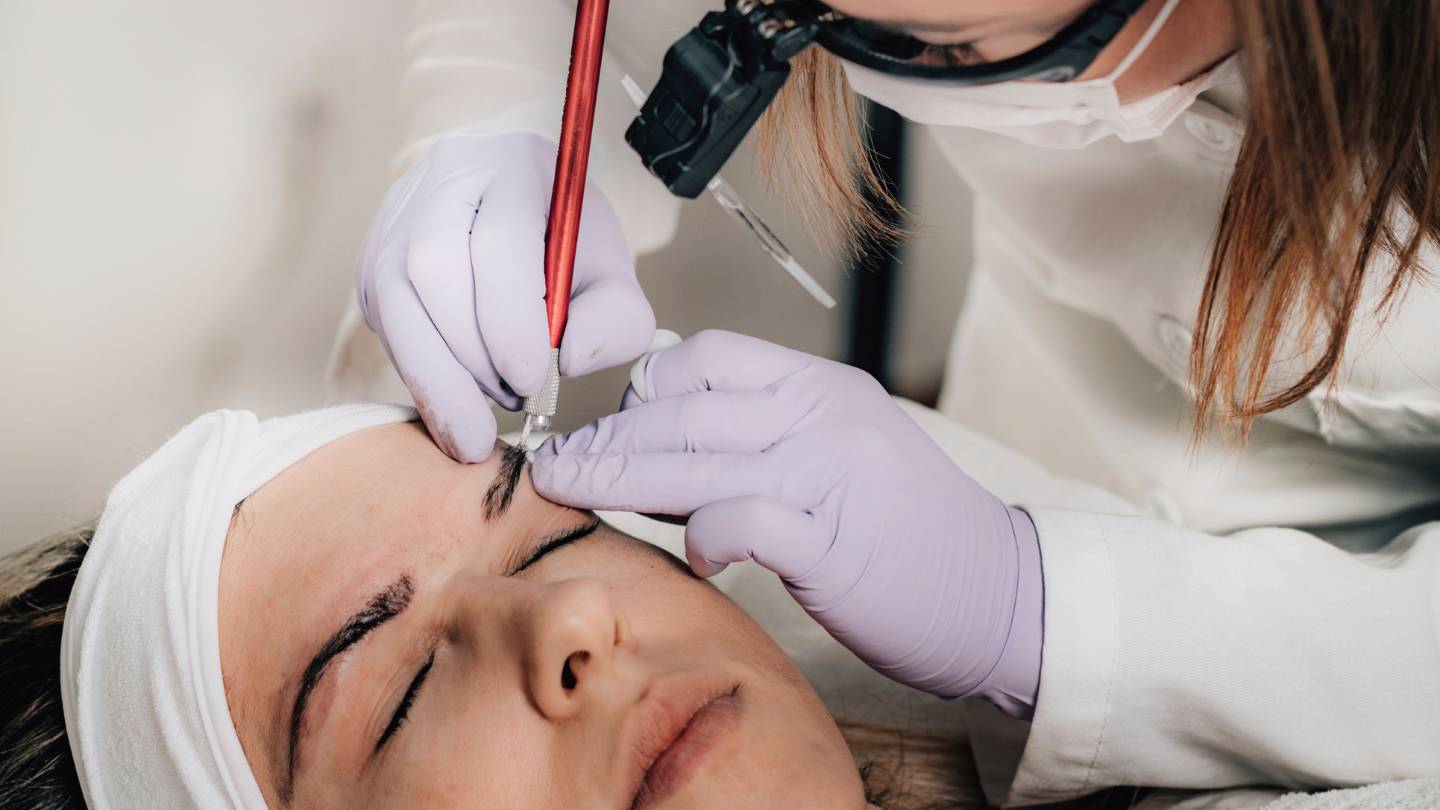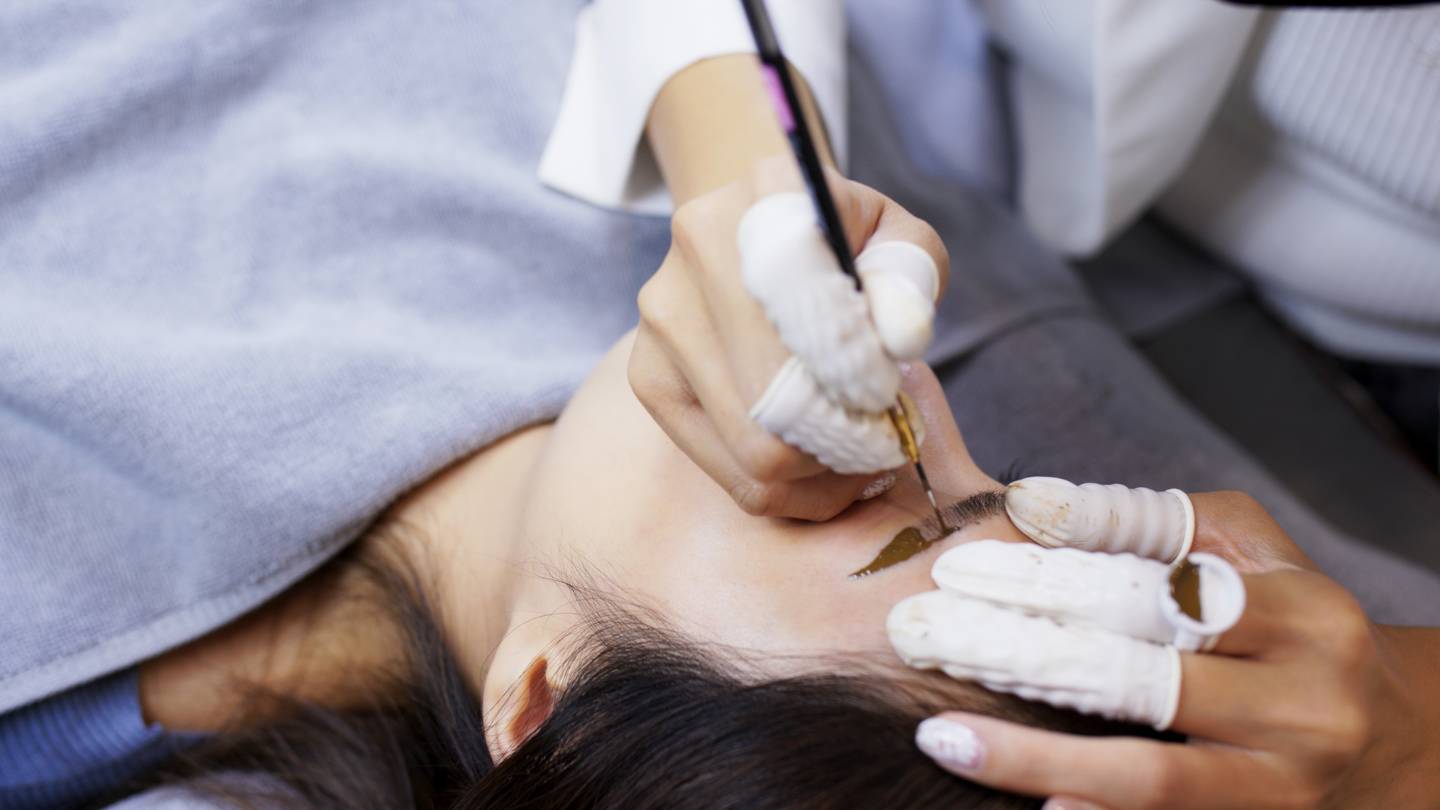Did you ever wonder how celebs got their beautiful brows? Microblading is usually involved. What happens after you've had this revolutionary surgery to keep your brows perfect? The aftercare of microblading is crucial, not only a passing worry.
The endurance, vibrancy, and natural appearance of your freshly microbladed eyebrows are determined by how you care for them. It's all about protecting your work on improving your facial features.
It could be difficult to figure out what to do after microblading. With so much information, how can you choose what's important? We will draw on the advice of experts, dispel common misconceptions, and lay out a detailed plan for post-procedure care in this exhaustive guide. Looking to take your eyebrow game to the next level with permanent results? How about we go off on this educational adventure side by side?
Microblading Eyebrows: What Is It?
In microblading, coloured ink is inserted near or inside the eyebrows for a pigmented or tattooed look. The technician uses a little tool with tiny bladed nibs to tattoo the brows. The process of microblading eyebrows requires two appointments. Assuming you take excellent care of your microblading, it might endure for three years. If you want to take your beauty to the next level, microblading is the way to go.
What is the Duration of Aftercare for Microblading?
Seven to fourteen days is the typical duration for microblading aftercare. While the healing time for microblading is four to six weeks, the time spent caring for the procedure is minimal. Be very careful when healing from microblading; this is a crucial step. Scabbling is the most delicate step. Then you can unwind for a while.
What Aftercare Options Are Available for Microblading?
There are two types of care for eyebrows that have been microbladed:
- dry healing
- wet healing
Both methods involve cleansing the brows, but one requires an ointment, and the other does not.
Wet Healing Has Several Steps:
- Use sterile water to cleanse your brows gently.
- Use a clean cotton pad to blot them dry gently.
- Dabbing on some aftercare ointment.
Take a risk or stay still! Sunglasses, especially large ones, can shield your eyeliner and eyebrows from the sun's rays when the weather gets heated. Be careful not to get anti-aging skin care products on your lips, brows, or eyes.
Because of its resurfacing components, such as salicylic acid, anti-aging moisturisers and serums should not be applied to the regions that have been enhanced; doing so may cause your effects to fade too quickly.
Two Dry Healing Methods Exist.
- First, wash and dry your brows carefully, but don't use ointment.
- The second one is a bit more severe; it calls for absolutely no bathing and the use of any topical ointments. Just avoid getting your brows wet till they heal on their own. Most microblading artists no longer advise this technique because it might lead to issues if you wait to wash your brows afterwards.
How to Take Care of Your Skin After Microblading By Experts:
There are two things to keep in mind while you wait for your microbladed brows to heal:
- A shade of brown seeped into the brows.
- Areas of skin within and surrounding your eyebrows.
- After microblading, pigment maintenance will make the results last longer, and skincare will speed the healing process.
Basic Microblading Aftercare Rules
The fundamentals of microblading aftercare are as follows:
- Be very careful when washing your face, especially around the treated region. Use a clean tissue to pat it. Put away that brow pencil.
- Be sure to follow your microblading artist's instructions when using goods. Skincare products can affect pigmentation if they contain acids or exfoliants. Therefore, it's best to avoid using them on your own.
- Remove the scabs as they come off. Please don't pick them because removing pigment is a pain and will take a long time to cure.
- Always use a fresh pillowcase, preferably silk-made, and avoid sleeping on your face.
- Take a break from makeup for ten days. Makeup artists warn against avoiding the treated region when applying or removing makeup, which could lead to more skin irritation. Instead, focus on applying makeup to the rest of your face.
- Stay away from saunas, long showers, swimming pools and the ocean.
- Stay out of the sun, and don't tan.
As you can see, the fundamental aftercare guidelines are quite stringent. Makeup and other cosmetics are strictly forbidden. Because of this, you should schedule your microblading session well in advance. Remember that your brows require time to recover before you can have the touch-up. Thus, getting the therapy at least two months before a significant occasion or vacation is recommended.
What To Do After Microblading On Oily Skin
The results of microblading are more noticeable and long-lasting in people whose skin is naturally dry. Only some are fortunate enough to have oily skin. This occurs when the skin's natural oils, known as sebum, work to draw out the pigment. Having microbladed eyebrows is still an option for them.
While it is possible, microblading greasy skin requires additional post-treatment maintenance. Since dry healing doesn't require further moisturising, it's often suggested for clients with oily skin. Blotting your microbladed eyebrows multiple times daily is recommended. They must be kept dry.
Aftercare Ointment For Microblading Eyebrows
It would help if you put your faith in your artist not only for the treatment but also for the aftercare instructions. Follow the application instructions for the aftercare ointment precisely if your artist has recommended moist healing.
Apply the ointment that your microblading artist has prescribed. You can usually count on most artists to supply you with all the aftercare supplies you need. Common ingredients in aftercare ointment include panthenol and glycerine.
Coconut oil and lotions containing virgin olive or avocado oil have received positive reviews from other artists. An effective antimicrobial product is an ointment that combines honey with propolis. Shea butter, cocoa butter, beeswax, and other similar substances may be present in some of the items. Are you allergic to anything? If so, please inform your artist.
The application of the ointment requires caution. Too much of it will cause your pores to become clogged. You should use a small amount of the cream rather than a heavy covering. Dab a small amount onto each brow using a Q-tip dipped in the ointment. This should be done three times daily. Applying the ointment before and after a shower can help keep your brows covered for the greatest results.
Daily Microblading Aftercare Guide
It is critical to adhere to these post-microblading care instructions for the best possible healing of your skin. For your convenience, we have divided these suggestions into manageable daily and weekly portions in case they appear too much at once. This daily guide will make sure you take all the important actions. All set to begin?
Day 1 To 2
Your eyebrows may experience some redness, tenderness, and swelling following your microblading process. Bruising and bleeding, though slight, are also possible. Pick one of these approaches while your skin recovers:
Dry Healing Method
- After applying the treatment, remove any surplus fluids with a clean tissue. Keep your hands clean to avoid sickness.
- Maintain a dry environment. Water may irritate or burn you because your skin is still delicate and undeveloped. Additionally, water can hinder the healing process and even invite bacteria and germs to infiltrate the treated region.
- Lastly, avoid applying additional products to your skin for the first two days.
Dry-Healing Approach
- During the first day, wash the tattooed area every three hours.
- After bathing, apply the aftercare ointment.
- Your eyebrows should be washed twice daily from day 2 to day 7.
Day 3 To 7
You should expect some peeling and scabbing as your eyebrows recover. Itching after microblading is also prevalent. Remember them throughout this time:
- No matter how much the scabs itch, you should not pick or scrape at them. If you do this, the healing process will be interrupted, and the effects can be uneven or fading.
- Your microbladed eyebrows are ready to be washed. Before handling the treated area, ensure that your hands are clean.
- Use antibacterial soap or a mild cleaner in sterile water for washing.
- The treated region should not be rubbed. Instead, move in gentle, circular motions for the next ten seconds. Then, use a clean towel to pat the region dry after rinsing.
- After cleaning, use a cotton swab to put on your microblading aftercare ointment. This helps make a shield that prevents germs and lowers the risk of infection. But make sure you only use a small amount to not suffocate the skin.
- You may wash your face and apply the ointment once or twice daily, ideally in the morning and night, as directed by your expert.
- Avoid getting the treated area wet outside of these hours. To avoid getting water in your eyebrows while you bathe, lean your head back or use a shower cap.
Avoid These During Microblading Post-Care:
- Exercising, playing sports, and other physically demanding pursuits that could lead to perspiration
- Swimming, sauna, and jacuzzi sessions
- Tanning and sun exposure
- Chemical procedures such as peels, lasers, and more
- A variety of skincare items, including acids, retinol, lotions, sunscreen, and exfoliants
- Applying cosmetics all over the face.
- Repetitive stroking of the face and eyebrows
- Transportation by open-air means (e.g., automobiles, boats, motorbikes)
- Using alcohol, whether moderately or excessively
- Quit smoking and e-cigarette use at all costs.
- Cleaning airborne trash in the garage, basement, or attic
The microblading aftercare procedure includes these seemingly unreasonable restrictions. These can prolong microbladed eyebrow life and speed recovery.
Week 2
Your microbladed eyebrows might have fully scabbed by this point.
Remember These In The Second Week After Treatment:
- Let the flakes fall to the ground without contacting your treated area.
- Wash, pat dry, and moisturise your face every day.
- It is still advised that you stay out of the sun, don't wear makeup, and don't exercise.
Week 3 To 5
Most of the adverse effects should have faded by now, even though your skin is still healing. The microblading technique may even show you its natural effects.
From Week 3 To 5, Keep These In Mind:
- You are free to resume your regular schedule. This entails doing things like applying cosmetics and doing light exercises.
- Wearing sunscreen consistently can help you avoid overexposure to the sun.
- However, it would help if you refrained from using acids and exfoliants.
- Before your microblading touch-up, wait at least one day before scheduling skincare procedures.
Week 6 To 8
You should see full healing of your skin by week 6. If you notice any uneven shading or other problems with the colouration of your microbladed eyebrows, now is the time to schedule a touch-up appointment with your technician.
There is still an aftercare procedure for microblading touch-ups that you must adhere to. But it won't cover everything like the first microblading aftercare for your eyebrows.
Aftercare for Microblading 1 Year Later
Taking care of yourself in the days and weeks following microblading treatments is essential, but what you do afterwards is equally crucial. If you don't take precautions to preserve your microblading results, you can be in the treatment bed sooner than expected. Best practices for microblading aftercare over the long haul are outlined here.
Remember to use sunscreen. Use a moisturiser with an SPF every day to preserve your results. It would help if you didn't assume the sun isn't there simply because you can't feel its heat. Sunlight is the number one culprit for the rapid fading of microblading and permanent makeup.
Take a risk, or stay still! Sunglasses, especially large ones, can shield your eyeliner and eyebrows from the sun's rays when the weather gets heated. Be careful not to get anti-aging skin care products on your lips, brows, or eyes.
Because of its resurfacing components, such as salicylic acid, anti-aging moisturisers and serums should not be applied to the regions that have been enhanced; doing so may cause your effects to fade too quickly.
Conclusion
In microblading eyebrow surgery, coloured ink is put near or inside the eyebrows to make them look like they have tattoos or pigmentation. This process takes two visits and can last up to three years if everything is done right. There are two types of aftercare for microblading eyebrows: dry healing and wet healing. For dry healing, wash the brows with sterile water, pat them dry gently, and apply an aftercare cream.
Using clean water, a clean cotton pad and an aftercare lotion are all parts of wet healing. Glasses are not a good idea because they can block the sun's rays from makeup and eyebrows. For dry healing, you wash and dry the brows without using ointment. For wet healing, you don't need to bathe or use skin ointments.
It's important to take care of your skin after microblading by having a shade of brown in your brows and on the skin around and inside your eyebrows. Taking care of your pigment will make the benefits last longer, and using skin care products will help your body heal faster.
As basic aftercare rules, you should be careful when washing your face, use a fresh pillowcase, remove scabs as they come off, stay away from saunas, long showers, swimming pools, and the ocean, and not tan.
After microblading, oily skin is more visible and lasts longer, but it needs more care after the treatment. People with oily skin are often told to do dry repair and should blot their brows several times a day.
After microblading your eyebrows, you need to use an aftercare cream. Be careful when applying it; use a small amount on each brow and avoid thick layers.
The microblading treatment guide is broken up into daily and weekly chunks that are easy to follow so that the skin can heal as quickly as possible. As the guide starts with a dry mending method, the eyebrows may become red, sore, swollen, and have light bruises and bleeding. On the first day, you should wash the marked area every three hours and put on the aftercare cream. From day 2 to day 7, you should wash it twice a day.
From days 3 to 7, your skin will likely peel and scab, and it will probably also itch. To avoid this, don't work out, swim, use a sauna or jacuzzi, tan, get chemical treatments, use skin care products or makeup, stroke someone over and over, ride public transportation outside, drink alcohol, quit smoking, or clean up airborne trash.
This is the second week, and the eyebrows are fully healed. Remember to let them fall to the ground without touching the treatment area. Every day, wash, pat dry, and moisturise your face. Avoid the sun, don't wear makeup, and work out. Most of the bad effects should go away between weeks 3 and 5, but it's important to get back to normal activities like putting on makeup and doing light workouts.
Between weeks 6 and 8, your skin should be completely better by week 6. If you notice that the colour of your microbladed eyebrows isn't even or there are other problems with the way they look, make an appointment for a touch-up with your technician. The microblading touch-up aftercare will still need to be done, but it won't cover as much as the first microblading aftercare for your eyebrows.
Content Summary
- Microblading is a popular technique for achieving beautiful eyebrows, often used by celebrities.
- Aftercare is crucial for maintaining the endurance, vibrancy, and natural appearance of microbladed eyebrows.
- Proper care post-microblading helps protect the investment made in enhancing facial features.
- The guide aims to provide expert advice, dispel myths, and offer a detailed aftercare plan.
- Microblading involves inserting coloured ink near or inside the eyebrows for a pigmented look.
- The process requires two appointments and, with proper care, can last up to three years.
- Typical aftercare duration for microblading is 7 to 14 days, with full healing taking 4 to 6 weeks.
- Microblading aftercare includes two methods: dry healing and wet healing.
- Wet healing involves gentle cleansing with sterile water, drying, and applying aftercare ointment.
- Protecting brows from the sun and avoiding certain skincare products are important for healing.
- Dry healing methods vary, one involves washing and drying without ointment, and the other avoids water entirely.
- Expert aftercare advice focuses on pigment maintenance and skin care to aid healing.
- Basic aftercare rules include gentle face washing, and avoiding makeup and certain skincare products.
- Avoiding picking scabs and using a fresh silk pillowcase are recommended for better healing.
- Aftercare guidelines are strict, advising against makeup and exposure to certain environments.
- Microblading is more effective on dry skin, as oily skin can affect pigment retention.
- For oily skin, dry healing and frequent blotting are advised to keep brows dry.
- Aftercare ointments should be used as directed, and ingredients vary among products.
- Applying aftercare ointment correctly is important to avoid clogging pores.
- A daily aftercare guide helps manage the healing process in manageable steps.
- Initial days post-microblading can involve redness, tenderness, and potential bruising.
- Dry healing involves keeping the area dry and avoiding additional products initially.
- For wet healing, regular washing and ointment application are key in the first week.
- From day 3 to 7, avoid picking scabs, wash gently, and apply ointment sparingly.
- Activities to avoid include exercise, swimming, sun exposure, and using certain skincare products.
- By week 2, scabbing should be complete, and daily face washing and moisturising continue.
- From week 3 to 5, normal activities can resume but avoid harsh skincare treatments.
- By week 6, the skin should be healed, and any uneven shading should be assessed.
- Long-term aftercare includes using sunscreen to protect against rapid fading.
- Sunglasses can help protect microbladed brows from sun exposure.
- Avoid anti-aging products with resurfacing components on treated areas.
- Regular sunscreen application is key to maintaining microblading results.
- Microblading touch-ups require their own aftercare routine.
- Long-term care beyond immediate aftercare is crucial for lasting results.
- Microblading's effectiveness is influenced by individual skin types and care routines.
- Personalised aftercare instructions from the microblading artist are important to follow.
- The success of microblading is partly dependent on adherence to aftercare guidelines.
- Healing experiences may vary, and personal observations are important.
- Avoiding water and harsh products in the initial healing phase is essential.
- Gentle cleansing and care of the microbladed area help prevent infection.
- Being cautious with makeup application near treated areas is advised.
- Understanding and following the specific steps of chosen healing methods is crucial.
- Consulting with a microblading professional for tailored advice can enhance results.
- Awareness of potential allergic reactions to aftercare products is important.
- Keeping the microbladed area clean and protected aids in optimal healing.
- Adjusting daily routines to accommodate microblading aftercare can be necessary.
- Recognising the signs of proper healing versus complications is important.
- Consistent aftercare practices play a significant role in the longevity of microblading results.
- Being informed about the microblading process and aftercare enhances satisfaction with results.
- Ongoing care and touch-ups are part of maintaining microbladed eyebrows over time.
Frequently Asked Questions
After undergoing a microblading procedure, proper aftercare is crucial to ensure the longevity and appearance of the eyebrow enhancement. The aftercare regimen helps prevent infections, ensures optimal healing, and maintains the pigment's vibrancy. Neglecting aftercare instructions can lead to fading, uneven colour, or even potential infections.
It's essential to wait for at least 24 to 48 hours after the microblading procedure before getting your eyebrows wet. This waiting period allows the newly implanted pigment to settle into the skin. Once you're past this initial phase, you can gently wash your eyebrows with lukewarm water and a mild, fragrance-free cleanser. Avoid scrubbing or rubbing the area to prevent premature fading.
It's advisable to avoid activities that cause excessive sweating or expose the treated area to water for the first week after microblading. This means refraining from rigorous exercises, swimming, or any activity that might make you sweat heavily. Intense sweating and exposure to water can push out the pigment and interfere with the healing process. It's best to wait until the healing is complete before resuming such activities.
The healing process after microblading typically takes around 4 to 6 weeks. Initially, you might notice some scabbing, itching, and flaking, which are all part of the natural healing process. It's essential to resist the urge to pick or scratch the treated area. Over time, the color will soften and settle, and any initial darkness will lighten. Attend any recommended touch-up sessions to perfect the brows and ensure the best results.
Yes, there are several things to avoid during the healing phase after microblading:
- Direct Sunlight: Exposing your eyebrows to direct sunlight can cause the pigment to fade prematurely. Always wear a hat or sunglasses when outdoors and apply sunscreen after the healing process.
- Makeup and Skincare Products: Avoid applying makeup or skincare products directly on the treated area until it's fully healed. Ingredients in certain products can interfere with the healing process or cause irritation.
- Chemical Peels and Facials: Steer clear of chemical peels, facials, or any treatments that exfoliate the skin in the eyebrow area for at least four weeks post-microblading. These treatments can prematurely fade the pigment.



